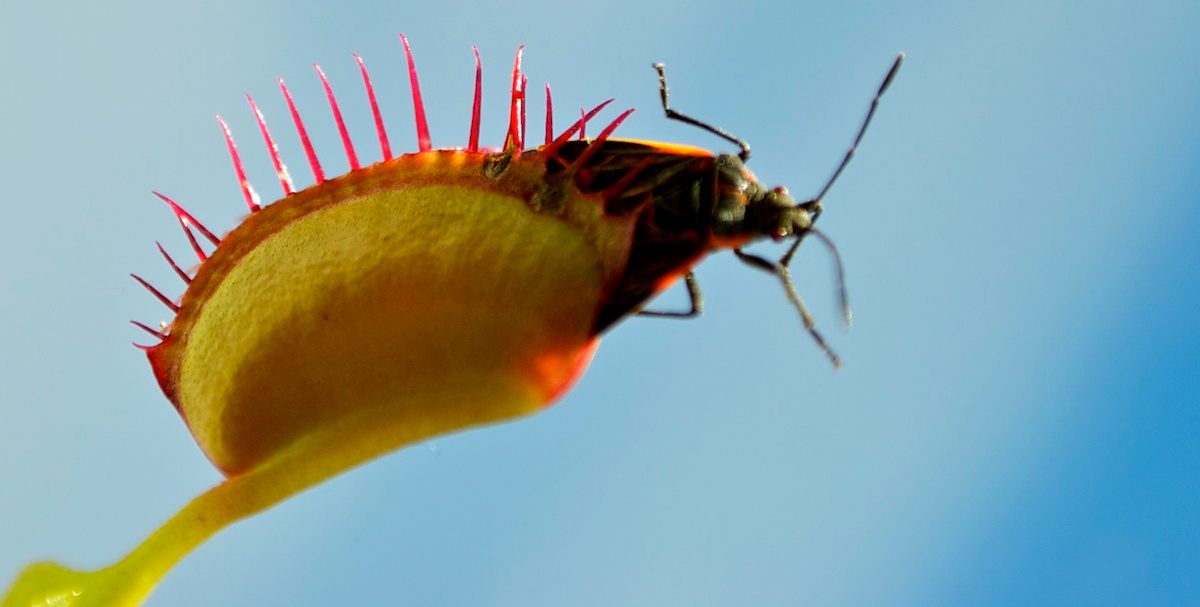Venus Flytraps Are a ‘Horrid Prison,’ But Only for Certain Insects
Medium-size bugs beware.

In the late 19th century, Charles Darwin had a colleague in North Carolina send him Venus flytraps in the mail. When he received the carnivorous plants, he pried them open to see what was inside (insects and a centipede), and tested their trigger and digestive mechanisms. He asked, “Can you use a hair? Can you use boiling water? Can you chop up a trap?” says Christopher Martin, an evolutionary biologist at the University of North Carolina at Chapel Hill, who led a study with undergraduates to examine flytraps’ fierce, fangy, floral maws. Darwin didn’t have the traps for long—they soon died—but through the tests, he was able to prove to himself and the world that these plants really do eat meat. But since then, surprisingly little research has explored what makes the plants effective ambush hunters. The new study by Martin takes a closer look at the spiky trichomes that form the bars of what Darwin termed a “horrid prison.”
While they can be purchased for a few bucks from Walmart, wild Venus flytraps are only found in a sliver of the Carolinas, a 75-mile radius around the coastal city of Wilmington, North Carolina, home to the only public carnivorous plant garden in the world. The longleaf pine savannas to which they are endemic are “an acidic swampy marsh environment,” Martin says, where the tall trees allow lots of light to stream down to the forest floor. The soils there aren’t particularly nutrient-rich, so insects’ fluids, soft flesh, and exoskeletons provide the flytraps with what they need to survive—nitrogen in particular. “It’s a cost-benefit ratio,” says Martin. “Nitrogen is so rare in this habitat that it’s better to have traps than not.” In the wild, though, the plants are at risk of extinction, due to the encroachment of suburban developments and golf courses.

Martin and his students conducted their study at the Green Swamp Preserve, in the semi-natural North Carolina Botanical Garden in Durham, and in a lab so that they could compare their results across different environments. In the lab, Martin and his undergraduate research team placed crickets on makeshift ramps—for easy delivery to their doom. Surprisingly, the plants there had a relatively low success rate for capturing prey once they had been triggered to close, around 16 percent. While the traps snap shut in milliseconds, it is the teeth—what the biologists call “marginal spikes”—that seal off an insect’s escape route, closing tighter over the course of a couple hours as enzymes liquify the insect into a digestible meal. For the second round of the lab study, the researchers gave the flytraps “haircuts,” meticulously snipping their hair-spike-teeth to deprive them of the prison bars that locked crickets inside. “You’d think the trap would hate that and just drop dead, but they regrow,” Martin says. Without their teeth, the traps were unsurprisingly even less successful—less than six percent of traps caught a meal. These results from the lab were slightly different in the botanical garden, where spiky plants caught prey about 13 percent of the time, while shorn ones caught around nine percent.
The results show that the spikes really do help to ensnare prey, but their effectiveness depends on insect size. Small insects such as flies can simply squeeze out before the teeth close tight enough to head off their escape route. Larger crickets could grab onto a tooth and use it to haul themselves out. In fact, the shorn plants were just as good at catching large prey than the unshorn ones were. So the trap and teeth are really only suited to medium-sized insects, such as regular crickets, who are too large to climb out from between them, and not strong enough to fight their way out. Evolution has given Venus flytraps an appetite, but it’s also made them unintentionally picky eaters.




































Follow us on Twitter to get the latest on the world's hidden wonders.
Like us on Facebook to get the latest on the world's hidden wonders.
Follow us on Twitter Like us on Facebook